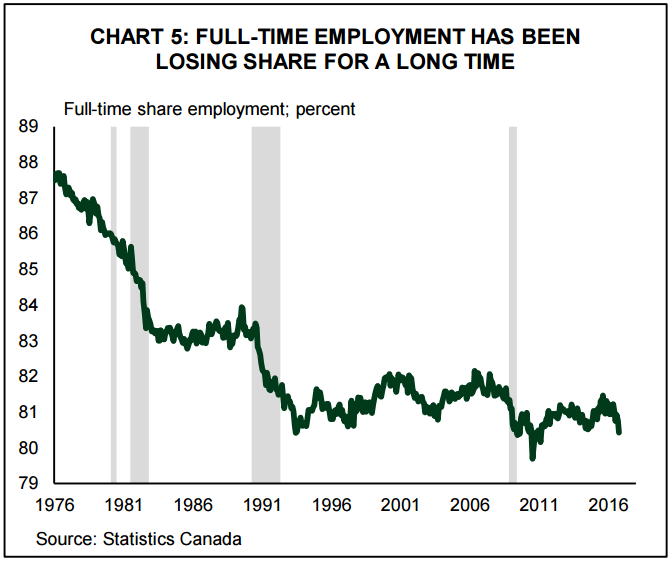Canada has created jobs in every year since the 2009 recession.

That sounds great on the surface. But TD Economics scratched just a little deeper and found that almost every job created last year was part-time, in a report released Wednesday.
READ MORE: Jobs report: The top 4 growing employment sectors in Canada
The year 2016 marked Canada’s seventh straight of “solid employment gains,” according to the report by economists Beata Caranci and James Marple.
That was enough for the economists to wish a “kudos to the Canadian job market.”
But it wasn’t enough to impress them; and the reason is clear from the chart below.

There are numerous reasons why almost all the jobs created last year were part-time. One is slumping employment activity in oil-producing provinces like Alberta, Saskatchewan and Newfoundland and Labrador.
Together, those provinces lost 65,000 full-time jobs up to November; that drop is equivalent to more than one per cent of total full-time jobs across Canada, and it’s “more than sufficient to bring the national tally into negative territory.”
Those provinces only created 30,000 part-time jobs in the same period.
WATCH: Concerns surround type of work added to Canada’s labour market

But energy-producing provinces aren’t the only ones seeing comparatively weak full-time job growth.
Full-time jobs only grew by 0.5 per cent year-over-year up to November in all other provinces; meanwhile, part-time jobs in those areas jumped by a much stronger 6.1 per cent.
Only sectors tied to real estate, like finance and insurance, bucked the trend and saw strong full-time job growth.
And that could present a problem: “Higher interest rates, stretched valuations and tighter regulations foretell an inevitable slowdown within this sector.”
READ MORE: Jobs that will see big pay increases in 2017
Real estate-related industries like construction and finance positions made up a “whopping 75 per cent” of new full-time jobs in non-energy producing provinces in 2016, the report said.
In Ontario, 68 per cent of full-time positions were in these industries; in B.C., it was more than 100 per cent of the growth.
“In other words, in the absence of this sector, there would be an outright decline in full-time jobs in the province,” Caranci and Marple wrote.
Cooling housing activity could pull back on full-time job growth moving forward, they said.
READ MORE: Vancouver home sales drop 5.6 per cent in 2016
But full-time work as a share of employment has been declining for decades, the economists added.
It’s a trend that’s been happening since the late 1980s, and that accelerated with the 2009 recession, as the following chart shows.

There are a few possible explanations for the growth of part-time work.
One is that changes to Employment Insurance (EI) allow people to keep receiving benefits even as they return to the workforce.
Another is that the service sector has come to make up a stronger share of employment than the goods-producing sector; services generate a “greater share of part-time positions,” the report noted.
“It would not take much for full-time work to make something of a comeback given the low bar set last year.”
Overall, TD Economics expects employment to grow by 0.5 per cent in 2017, down from 0.8 per cent last year.
The lack of full-time growth in 2016 does present one advantage, however: it can’t get much worse.
“It would not take much for full-time work to make something of a comeback given the low bar set last year,” the report said.




Comments